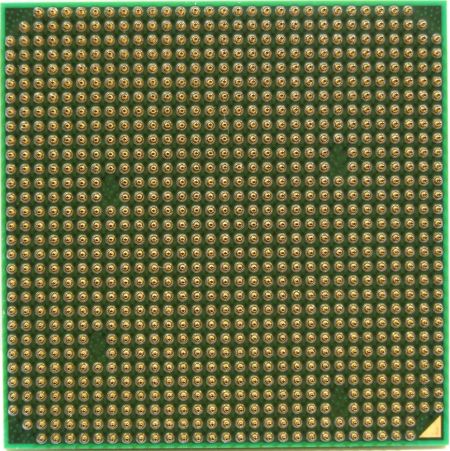AMD Phenom 9600 Black Edition: New Hope?
Overclocking - Hitting The Limit At 2.70 GHz
We attempted to increase the CPU's frequency from 2.60 GHz to 2.70 GHz while retaining the default core voltage of 1.250 V. Since the Phenom lets you choose half multiplier steps, we tried raising the clock speed by 100 MHz using the 13.5x multiplier, but the system instantly became unstable. Therefore, we increased the core voltage step by step until the CPU became stable once more. Only after we had reached a core voltage of 1.400 V (+ 0.150 V) could we convince the system to complete the Prime 95 torture test without incident. Overclocking any further to 2.80 GHz proved completely impossible, despite further voltage increases.
The back of our Phenom 9600 Black Edition.
In our opinion, 1.400 V is too high for everyday operation for a 65 nm Phenom, as it carries too much risk of damaging the CPU.
It is obvious that we should not expect any high-frequency models as long as the Phenom uses the B2 stepping. On the other hand, there are B2-Phenoms that are able to reach 3.00 GHz, as we saw at the Phenom launch event - there is no rule by which you can determine a CPU's potential. Overclocking the Phenom processor is a matter of luck, and by no means as sure a bet as it is with the Core 2 processors of AMD's rival Intel.
Get Tom's Hardware's best news and in-depth reviews, straight to your inbox.
Current page: Overclocking - Hitting The Limit At 2.70 GHz
Prev Page Overlocking By 13.04% - 2.60 GHz Next Page Overclocking - Hitting The Limit At 2.70 GHz, ContinuedTom's Hardware is the leading destination for hardcore computer enthusiasts. We cover everything from processors to 3D printers, single-board computers, SSDs and high-end gaming rigs, empowering readers to make the most of the tech they love, keep up on the latest developments and buy the right gear. Our staff has more than 100 years of combined experience covering news, solving tech problems and reviewing components and systems.
-
ShadowKai I think on page 14 the author meant:Reply
"When Cool'n'Quiet is deactivated, idle power consumption rises to 51 watts. The jump in power consumption at 2.70 GHz is a direct result of the core voltage increase from 1.250 V to 1.400 V."
And the bars for Phenom 9600 BE and Phenom 9600 BE (CnC) should be switched around.
-
I think it's also important to mention the fact that Vista SP1 includes it's OWN TLB fix which overrides the bios setting of many boards. I used an app that works in conjunction with Crystal CPUID to change the MSR directly to deactivate this secondary TLB fix. It caused a dramatic improvement in performance; the quick and simple WinRAR bench went from 232 to ~1300 after the fix. Just think it's worth mentioning!Reply
-
I think I may have found a new problem with this bug. I have a Phenom X4 9600, and have tried two different motherboards. The problem occurs when running Windows 7. BSOD with a message stating that the operating system did not receive an clock interupt signal from the second processor. At first I thought it was a bios problem, but have since had to replace the motherboard. Tried Windows 7 again after replacing the motherboard and still having the same problem.Reply

